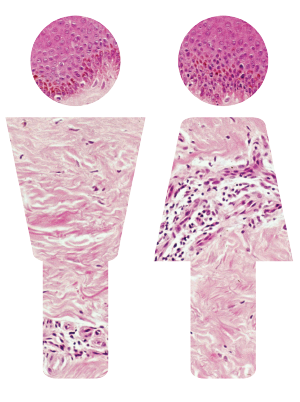
Biophoto Associates / Science Source; GN ILLUSTRATOR / SHUTTERSTOCK.COM
Systemic sclerosis (SSc) is a disease characterized by immunologic abnormalities, microvascular involvement and tissue fibrosis. In previous studies, 10-year survival rates ranged from 50–84%. However, there are concerns that these studies, using prevalent cohorts, are underestimating mortality.
“While the prognosis of many rheumatic diseases has improved with the availability of more effective and targeted therapies, mortality in SSc remains unacceptably high,” says Mandana Nikpour, MD, PhD, from the Departments of Rheumatology and Medicine at St. Vincent’s Hospital and the University of Melbourne, Australia. “Our goal was to accurately quantify the huge burden of mortality in scleroderma, highlighting the urgent need for new, effective therapies.”
International, Multi-Center Study
The researchers studied nearly 4,400 subjects over a median follow-up of 3.0 years (interquartile range 1.0 to 5.1 years). Information was obtained from the Australian Scleroderma Cohort Study, the Canadian Scleroderma Research Group, and the Madrid University Hospital 12 de Octubre Scleroderma Cohort Study. The Madrid group is a single-center cohort and the others are multi-center.1
The inception group (1,070 subjects) was defined as a subset of people recruited within four years of onset of first symptoms. The prevalent group (3,218) included all registered subjects, regardless of duration at entry.
Dr. Nikpour notes that all of those enrolled in the inception cohort were also included in the prevalent one. Because of this, they undertook extra analyses to remove inception cohort members from the prevalent cohort. Those remaining in the prevalent cohort were referred to as the non-inception cohort.
Followed from Onset
“We hypothesized that a lot of deaths occur early in the course of scleroderma and that the true burden of mortality can be underestimated unless a large cohort of patients is followed from early in the disease course (i.e., close to disease onset),” says Dr. Nikpour. “[Because] scleroderma is a relatively uncommon disease, in order to have a large enough group of patients followed from disease onset (inception cohort) to enable meaningful analyses, we needed to combine data from cohorts around the world.”

Dr. Nikpour
To do this, Dr. Nikpour and Yanjie Hao, MD, collaborated with Murray Baron, MD, and Marie Hudson, MD, MPH, of Montreal and Patricia Carreirs, MD, of Madrid to create a pooled data set of 1,070 incident cases from Australia, Canada and Spain. They compared mortality and causes of death with a pooled, prevalent cohort of patients recruited at various disease stages, sourced from the same countries. This inception cohort was the largest reported to date.


